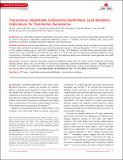| dc.contributor.author | Kramer, Daniel B | en_US |
| dc.contributor.author | Hatfield, Laura A | en_US |
| dc.contributor.author | McGriff, Deepa | en_US |
| dc.contributor.author | Ellis, Christopher R | en_US |
| dc.contributor.author | Gura, Melanie T | en_US |
| dc.contributor.author | Samuel, Michelle | en_US |
| dc.contributor.author | Retel, Linda Kallinen | en_US |
| dc.contributor.author | Hauser, Robert G | en_US |
| dc.date.accessioned | 2015-11-03T15:58:28Z | |
| dc.date.issued | 2015 | en_US |
| dc.identifier.citation | Kramer, Daniel B, Laura A Hatfield, Deepa McGriff, Christopher R Ellis, Melanie T Gura, Michelle Samuel, Linda Kallinen Retel, and Robert G Hauser. 2015. “Transvenous Implantable Cardioverter-Defibrillator Lead Reliability: Implications for Postmarket Surveillance.” Journal of the American Heart Association: Cardiovascular and Cerebrovascular Disease 4 (6): e001672. doi:10.1161/JAHA.114.001672. http://dx.doi.org/10.1161/JAHA.114.001672. | en |
| dc.identifier.issn | 2047-9980 | en |
| dc.identifier.uri | http://nrs.harvard.edu/urn-3:HUL.InstRepos:23474039 | |
| dc.description.abstract | Background: As implantable cardioverter-defibrillator technology evolves, clinicians and patients need reliable performance data on current transvenous implantable cardioverter-defibrillator systems. In addition, real-world reliability data could inform postmarket surveillance strategies directed by regulators and manufacturers. Methods and Results: We evaluated Medtronic Sprint Quattro, Boston Scientific Endotak, and St Jude Medical Durata and Riata ST Optim leads implanted by participating center physicians between January 1, 2006 and September 1, 2012. Our analytic sample of 2653 patients (median age 65, male 73%) included 445 St Jude, 1819 Medtronic, and 389 Boston Scientific leads. After a median of 3.2 years, lead failure was 0.28% per year (95% CI, 0.19 to 0.43), with no statistically significant difference among manufacturers. Simulations based on these results suggest that detecting performance differences among generally safe leads would require nearly 10 000 patients or very long follow-up. Conclusions: Currently marketed implantable cardioverter-defibrillator leads rarely fail, which may be reassuring to clinicians advising patients about risks and benefits of transvenous implantable cardioverter-defibrillator systems. Regulators should consider the sample size implications when designing comparative effectiveness studies and evaluating new technology for preventing sudden cardiac death. | en |
| dc.language.iso | en_US | en |
| dc.publisher | John Wiley & Sons, Ltd | en |
| dc.relation.isversionof | doi:10.1161/JAHA.114.001672 | en |
| dc.relation.hasversion | http://www.ncbi.nlm.nih.gov/pmc/articles/PMC4599526/pdf/ | en |
| dash.license | LAA | en_US |
| dc.subject | ICD leads | en |
| dc.subject | implantable cardioverter-defibrillators | en |
| dc.subject | postmarket surveillance | en |
| dc.title | Transvenous Implantable Cardioverter-Defibrillator Lead Reliability: Implications for Postmarket Surveillance | en |
| dc.type | Journal Article | en_US |
| dc.description.version | Version of Record | en |
| dc.relation.journal | Journal of the American Heart Association: Cardiovascular and Cerebrovascular Disease | en |
| dash.depositing.author | Kramer, Daniel B | en_US |
| dc.date.available | 2015-11-03T15:58:28Z | |
| dc.identifier.doi | 10.1161/JAHA.114.001672 | * |
| dash.contributor.affiliated | Kramer, Daniel | |
| dash.contributor.affiliated | Hatfield, Laura | |


